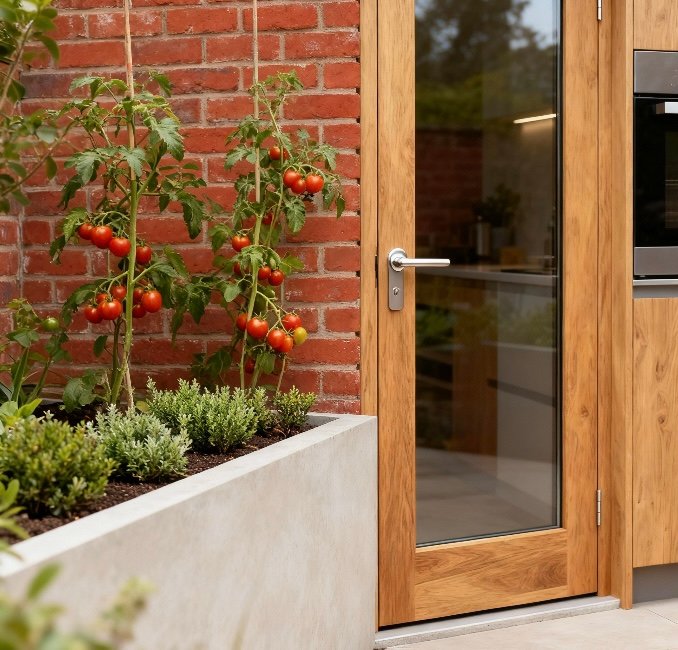Kitchen Gardens Part 2 – A Step-by-Step Guide

If you read our Kitchen Gardens – Part 1: From Windows to a Dooryard Garden, you know that you don’t need a backyard to enjoy fresh herbs and veggies. Just a little creativity and a sunny spot. Whether you’re in a small apartment kitchen or have room for a classic outdoor garden, here’s how to get started.
Supplies You’ll Need
- Containers Small clay or ceramic pots for herbs
- Window boxes for lettuces and greens
- Hanging baskets or vertical wall planters for strawberries, tomatoes, or trailing herbs
- Raised planter boxes (if you have a bit more space outdoors)
Soil & Amendments
- Organic potting mix (lightweight and nutrient-rich)
- Compost or worm castings for extra fertility
- Perlite or pumice for drainage
- Plants & Seeds Indoors: basil, parsley, thyme, oregano, chives, cilantro, mint (keep mint in its own pot)
- Small veggies: salad greens, dwarf tomatoes, radishes, chili peppers
Outdoors
- Beans, cucumbers, zucchinis, root crops, and traditional kitchen herbs
- Flowers like nasturtiums or marigolds for pollinator support and pest control
Tools & Extras
- Watering can or spray bottle Small hand trowel
- Plant labels (popsicle sticks work fine)
- Optional: grow light for darker kitchens
Step-by-Step Setup
Step 1: Pick Your Growing Zone
Indoors: choose the sunniest windowsill, or add a grow light.
Outdoors: a sunny balcony, patio, or yard close to the kitchen for convenience.
Step 2: Choose Your Containers
Go vertical in small kitchens: wall planters, tiered shelves, or hanging baskets. Use railing planters or window boxes outside for salad greens.
Step 3: Prep Soil
Mix potting soil with compost and a little perlite for drainage. Avoid using garden soil in pots—it compacts and suffocates roots.
Step 4: Plant & Place
Herbs: plant one type per pot so they don’t crowd each other. Salad greens: sow seeds directly into shallow containers for a “cut-and-come-again” harvest. Fruiting plants (like tomatoes): give them the largest pots and sunniest spots.
Step 5: Care & Maintenance
Water regularly but don’t drown roots—let soil dry slightly between watering. Snip herbs often to encourage bushier growth. Fertilize lightly with compost tea or organic liquid feed every few weeks.
Step 6: Expand Beyond the Kitchen
If you have outdoor space, build a traditional kitchen garden (raised beds near your back door). Plant quick-grab foods like lettuces, peas, beans, and herbs you’ll use every day.
This setup keeps fresh flavour at your fingertips, adds greenery to your cooking space, and cuts down on store-bought packaging waste.
Seasonal Planting Guide
Here’s a seasonal planting chart for kitchen gardens (indoor vs. outdoor, month by month) tailored for Canada’s temperate zones (like NB, ON, QC, BC coast, Prairie cities).
Seasonal Planting Chart for Kitchen Gardens (Canada)
| Month | Indoors (Kitchen/Window/Grow Light) | Outdoors (Balcony/Backyard/Window Box) |
|---|---|---|
| January | Microgreens, sprouts, chives, parsley, mint | — |
| February | Basil, oregano, thyme, lettuces (under light) | — |
| March | Start tomatoes, peppers, and herbs indoors | Early hardy greens (if mild), overwintering kale |
| April | Lettuces, radishes, cilantro in pots | Cold-tolerant greens: spinach, kale, peas, radishes, carrots (under cover if frosty) |
| May | Keep starting seeds indoors | Plant outdoors: lettuces, beans, cucumbers, zucchini, potatoes, hardy herbs |
| June | Snip herbs regularly indoors | Plant warm-lovers outdoors: tomatoes, peppers, basil, squash, pole beans |
| July | Indoors: keep herbs trimmed | Outdoors: harvest greens, beans, peas; succession-sow lettuces and radishes |
| August | Indoor: start another round of basil and greens | Outdoors: harvest summer crops; sow fall crops (spinach, kale, radishes, carrots) |
| September | Indoors: microgreens, parsley, chives | Outdoors: late greens and root veg; bring in potted herbs before frost |
| October | Indoors: shift to herbs, sprouts, lettuces | Outdoors: final harvest, plant garlic and overwintering onions |
| November | Indoors: microgreens, mint, chives, oregano | — |
| December | Indoors: sprouts, microgreens, kitchen herbs | — |
Tips for Success
- Succession planting: Every 2–3 weeks, plant another round of quick crops like lettuces, spinach, or radishes.
- Portable pots: Keep herbs in smaller pots so you can move them in and out with the seasons.
- Grow lights: If your kitchen is shady in winter, a basic LED grow light makes year-round herbs possible.
